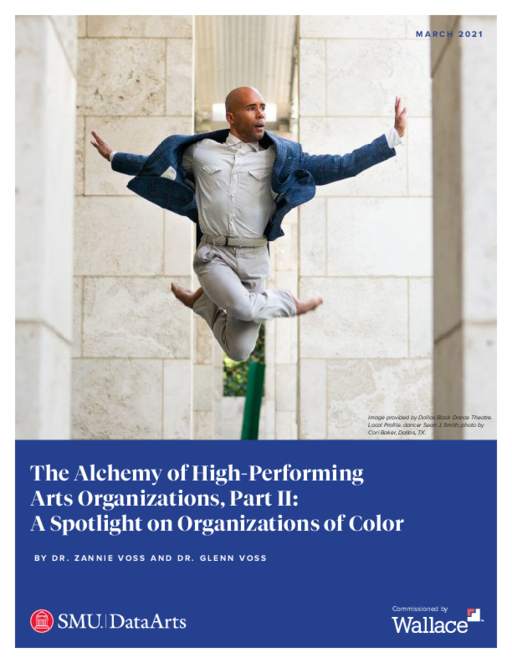
Breadcrumb
- Wallace
- Reports
- The Alchemy Of High-Performing A...
The Alchemy of High-Performing Arts Organizations, Part II
A Spotlight on Organizations of Color

- Author(s)
- Zannie Voss and Glenn Voss
- Publisher(s)
- SMU DataArts
Summary
How we did this
Researchers at SMU DataArts consulted several datasets to find high-performing arts organizations that primarily serve communities of color. They started by finding organizations who said in surveys that they "primarily serve a particular racial/ethnic group." Researchers then mined data from sources such as the Census Bureau, the National Endowment for the Arts, tax filings, and SMU DataArts' own databases. They found organizations that produce better financial outputs than one could expect from those organizations' inputs. They independently verified that those organizations do, in fact, serve communities of color. They then interviewed leaders of those organizations about the strategies behind their success.
This study is a follow-up to a 2020 report by SMU DataArts that identified elements high-performing arts organizations appear to share. It focuses on organizations that primarily serve communities of color. Researchers interviewed leaders of 21 such organizations and found that they bring many of the same assets to their work. But the challenges they face can be quite different.
The strengths of such organizations appear similar to those of organizations studied earlier. These organizations are built on a commitment to community and high artistic standards. Their boards and staffers understand and support the organizations' mission. Their cultures are built on trust, transparency, open communication, and respect. They adhere to long-term plans but are quick to adapt to changing circumstances.
Differences in Priorities and Challenges
There are also key differences between the two groups of organizations. Quality and community are critical for both groups, for example. But they have different priorities. Leaders interviewed for the first phase of research placed greater emphasis on high artistic standards. Those interviewed for the second phase said community was most important.

Organizations rooted in their community are very valued because it’s where people find their people.
— Leader of a high-performing arts organization that primarily serves a community of color
The challenges the two groups face are also different. The biggest hurdles the first group identified were declining audiences, changes in consumer preferences, changes in tax regulations, and difficulty meeting diversity and equity targets. Organizations in the second group mentioned none of these challenges. Organizations serving communities of color were more concerned about "racism, gentrification, and lack of equitable access to institutional funding."
With limited access to institutional funding, some organizations turn to their communities to help pay their bills. But many serve low-income communities with little ability to contribute. Organizations that can tap their communities for funding can grow and serve more people. Those that cannot remain effective but small.
Both groups of organizations recognize the importance of overhead costs such as marketing and fundraising. But many organizations serving communities of color cannot afford to invest in such administrative support. Executive directors or creative personnel often fill the gaps, leading to staff burnout and difficulty attracting new talent.
The focus on community can sometimes help organizations weather such headwinds. Many leaders interviewed in the first phase of research listed audience losses among their top concerns. None of the leaders interviewed for this study did the same. "Their commitment to meeting community needs, smaller size, and nimbleness may provide distinct advantages for survival," the report concludes. Indeed, even though the research was conducted in the depths of the Covid-19 crisis, 80 percent of interviewees said their organizations were "financially solid."
Key Takeaways
- High-performing arts organizations that primarily serve communities of color rest on a foundation of community orientation and high artistic standards. Other successful organizations place greater emphasis on high standards. These organizations focus first on their communities.
- The elements necessary to build on this foundation are similar to those observed in other successful arts organizations. They include adaptability, trust, transparency, and a shared commitment to an organization's mission.
- Special challenges confront organizations that serve communities of color. They include racism, gentrification, and a lack of access to institutional funding.
- Community orientation could help meet these challenges. Organizations serving communities of color seem to have more stable audience numbers than do other organizations. Most leaders interviewed for this study said their organizations were financially strong, even amid the Covid-19 crisis.
Materials & Downloads
Hear from the Organizations
Report author Zannie Voss discusses the keys to success with leaders of Sones de México Ensemble, Theater Mu, and Chicago Sinfonietta, three of the organizations explored for the report.
What We Don't Know
- This study is based on interviews with leaders of 21 high-performing arts organizations that primarily serve communities of color. Do its findings hold true for other organizations that also serve communities of color? Do they hold true for organizations that define their audiences not by race but by other characteristics, such as age, income level, sexual orientation, or gender identity?
- The analysis does not consider organizations that had less than four years of data available. Would the conclusions be different if the study included such organizations?
- Organizations studied in the second phase of research face challenges that are slightly different than those faced by organizations studied in the first phase of research. Are those challenges different because the organizations in the second phase serve communities of color? Or are they different because these organizations are, on average, smaller, leaner, and more nimble than those studied in the first phase?


